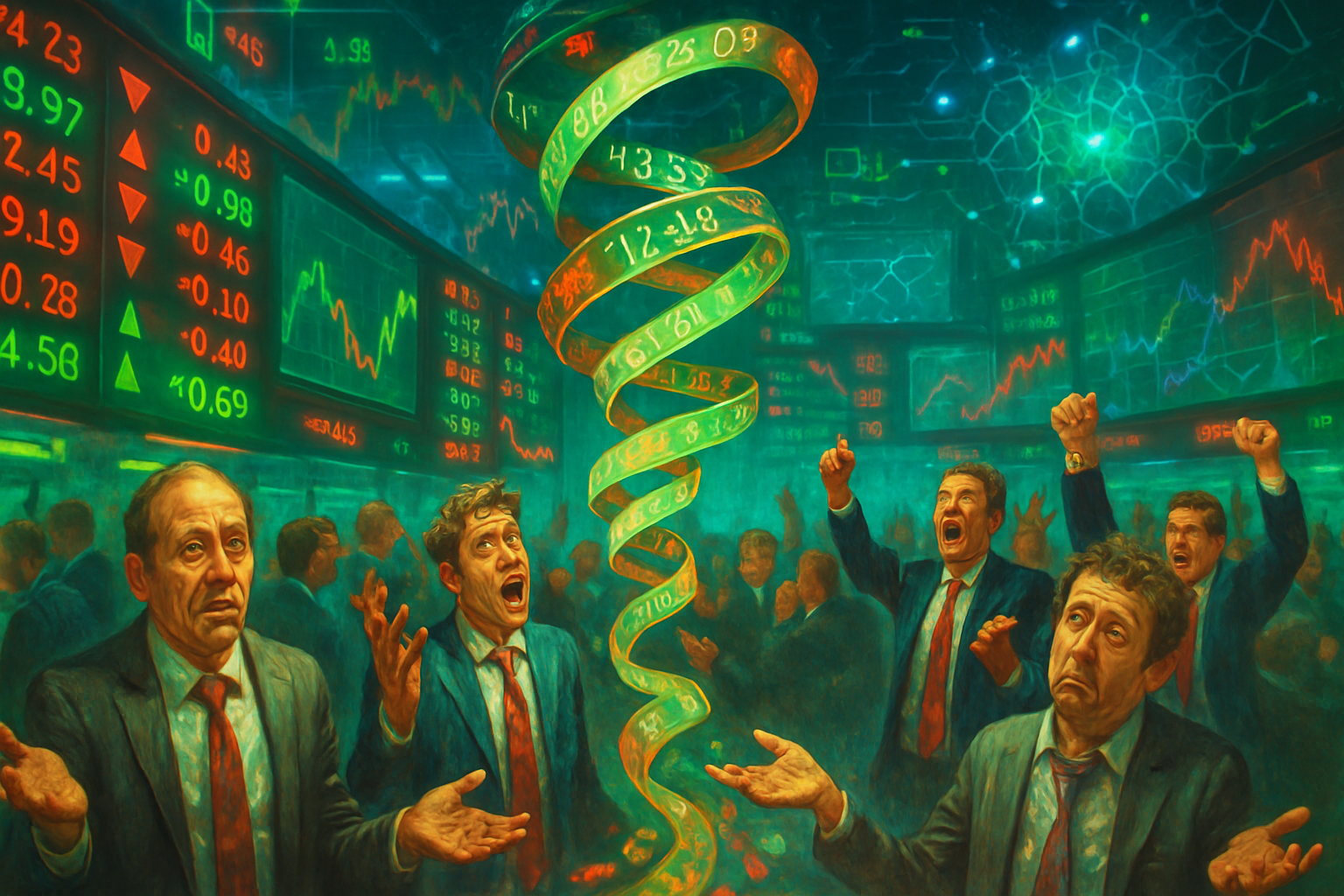
As October 2025 unfolds, the global stock market presents a perplexing paradox, leaving many seasoned investors and economists questioning the very foundations of rational market behavior. Despite a backdrop of persistent consumer anxiety, geopolitical turbulence, and a U.S. government shutdown, certain segments of the equity market, particularly technology, have continued their relentless ascent, propelled by the intoxicating promise of artificial intelligence and the expectation of further Federal Reserve interest rate cuts. This peculiar resilience in the face of mounting economic headwinds has ignited a fervent debate: are we witnessing a market driven by genuine innovation and fundamental strength, or have we entered an era of unprecedented irrationality, making it, perhaps, the "dumbest stock market in history"?
The current market environment is characterized by a palpable disconnect between soaring valuations and a less-than-stellar economic reality. While the Nasdaq Composite (NASDAQ: IXIC) repeatedly breaches new record highs, fueled by AI-linked giants like Nvidia (NASDAQ: NVDA) and Microsoft (NASDAQ: MSFT), broader economic indicators tell a story of caution. Consumer sentiment is faltering, job growth shows signs of weakness, and sticky inflation continues to gnaw at purchasing power. This stark divergence fuels the "dumbest market" thesis, suggesting a speculative frenzy where the allure of future technological breakthroughs and the promise of cheap money overshadow traditional metrics of value and risk.
The AI Euphoria and the Fed's Shadow: A Market Defying Gravity
The current market dynamic is heavily influenced by a potent cocktail of technological revolution and monetary policy expectations. The artificial intelligence boom remains the undisputed protagonist, driving monumental gains in the technology sector. Companies at the forefront of AI development and infrastructure are seeing their valuations skyrocket, often reaching levels that harken back to the dot-com era. This AI-driven rally is not merely a segment of the market; it is largely responsible for a significant portion of the S&P 500's (NYSEARCA: SPY) gains, profits, and capital expenditure, creating a concentrated leadership that raises eyebrows.
Adding fuel to this fire are the persistent expectations of Federal Reserve interest rate cuts. The Fed's quarter-point reduction in September 2025, coupled with widespread anticipation of further easing, has fostered a "buying the dip" mentality. Investors appear to be operating under a new paradigm where the promise of increased liquidity and lower borrowing costs outweighs immediate economic concerns. This "bad news is good news" phenomenon, where weaker economic data is interpreted as a precursor to more accommodative monetary policy, further illustrates the market's seemingly inverted logic. However, this reliance on central bank intervention creates a fragile ecosystem, vulnerable to any shift in the Fed's stance or an unexpected economic shock.
Despite these bullish drivers, the market is not without its anxieties. An ongoing U.S. government shutdown, though historically often shrugged off by investors, adds a layer of uncertainty. More significantly, renewed geopolitical tensions, including President Trump's declared intention for a "massive increase" in tariffs on Chinese imports, have triggered market jitters and highlighted the fragility of global trade. These external pressures, combined with a weakening labor market and persistent inflation, present a stark contrast to the celebratory mood in specific equity pockets. The market's ability to largely dismiss these fundamental headwinds, continuing its upward trajectory, is a central argument for those who view it as detached from reality.
The Victors and Vanquished in a Disconnected Market
In a market characterized by such pronounced disconnects, the beneficiaries and casualties are clearly delineated, often along sectoral lines. The undeniable winners are the "Magnificent Seven" or "megacap" technology companies, particularly those deeply entrenched in the AI ecosystem. Companies like Nvidia (NASDAQ: NVDA), a leader in AI chips, Microsoft (NASDAQ: MSFT), with its expansive cloud and AI integration, and Oracle (NYSE: ORCL), leveraging its enterprise software for AI applications, have seen their stock prices soar. These firms are not just growing; they are redefining market capitalization, attracting massive capital inflows, and commanding valuations that reflect exponential future growth rather than current earnings. Their dominance means that a significant portion of overall market gains is concentrated in a very few names, suggesting a narrow and potentially unsustainable rally.
Conversely, traditional industrial, consumer-facing, and even defensive sectors are struggling to keep pace. While the AI narrative drives tech, sectors like Consumer Staples (NYSEARCA: XLP) and Health Care (NYSEARCA: XLV) have lagged. These companies, often valued for their stable earnings and dividends, find themselves overlooked in a market hungry for high-growth, speculative opportunities. Small-cap stocks (NYSEARCA: IWM), while seeing a surge in September on hopes of reduced borrowing costs, still face significant headwinds from higher operational costs and tighter credit conditions compared to their larger, more established counterparts. Furthermore, companies with heavy exposure to international trade and those sensitive to geopolitical tensions, such as certain manufacturing or logistics firms, face increased volatility and uncertainty due to renewed tariff threats. The flight to "safety" has also seen Gold (NYSEARCA: GLD) prices surpass $4,000 per ounce, indicating underlying investor anxiety despite equity market highs.
Echoes of the Past: A Broader Context of Exuberance
The current market environment, with its blend of technological hype and elevated valuations, draws unsettling parallels to historical periods of speculative excess. The most frequently cited comparison is the dot-com bubble of 2000. Like then, a revolutionary technology (the internet vs. AI) is driving unprecedented excitement and investment, often leading to valuations that defy conventional metrics. The S&P 500's (NYSEARCA: SPY) CAPE ratio, a cyclically adjusted price-to-earnings measure, is reportedly approaching 40, a level only surpassed before the dot-com crash. This historical precedent serves as a potent warning, suggesting that even groundbreaking technologies can lead to market irrationality if investor enthusiasm outpaces fundamental reality.
This phenomenon of concentrated gains in a few "megacap" stocks also fits into a broader trend of market narrowness, which has historically preceded periods of correction or increased volatility. When a handful of companies disproportionately drive market performance, it signals a lack of breadth in the rally, making the overall market more susceptible to the fortunes of those few leaders. Regulatory bodies and policymakers are undoubtedly observing these trends with caution. While direct intervention might be limited, the International Monetary Fund chief Kristalina Georgieva has already voiced concerns about the risks to the global economy from potentially large corrections in lofty stock markets, hinting at a growing awareness of systemic risks.
Beyond historical comparisons, the market's ability to "shrug off" significant economic and geopolitical headwinds – from a government shutdown to faltering consumer confidence and renewed trade wars – signifies a deeper shift in investor psychology. This "bad news is good news" dynamic, where negative economic data is cheered for potentially prompting more Fed rate cuts, suggests a market heavily reliant on central bank intervention rather than organic economic growth. This reliance could lead to a moral hazard, where investors become complacent about fundamental risks, believing the Fed will always step in to prop up asset prices. The potential ripple effects on competitors and partners are also significant; smaller players in the tech ecosystem might struggle to compete with the vast resources and market dominance of the AI giants, potentially stifling broader innovation and market diversity.
What Comes Next: Navigating the Crossroads of Innovation and Risk
Looking ahead, the stock market stands at a critical juncture, with both exhilarating possibilities and significant perils on the horizon. In the short term, the trajectory of AI innovation will remain a dominant force. Continued breakthroughs and successful commercial applications could further fuel the rally in technology stocks, potentially extending the period of "irrational exuberance." Concurrently, market participants will be acutely focused on the Federal Reserve's next moves. Any deviation from the anticipated path of interest rate cuts, or an unexpected hawkish pivot, could trigger a swift and sharp market correction, particularly given the elevated valuations. Geopolitical developments, especially regarding trade tariffs, also pose an immediate risk, capable of introducing volatility and dampening investor confidence.
In the long term, the sustainability of the current market structure is a key question. If the AI revolution genuinely delivers on its transformative potential across industries, it could justify some of the current lofty valuations, leading to sustained growth for the pioneering companies. However, this also presents significant strategic challenges for companies that are not at the forefront of AI adoption. They will need to swiftly adapt, integrate AI into their operations, or risk being left behind. Market opportunities may emerge in overlooked sectors or in companies that successfully pivot to leverage AI, but are not yet priced for perfection. Conversely, a failure of AI to meet its hyperbolic expectations, or a broader economic slowdown, could expose the market's overreliance on a few tech giants, leading to a broader re-evaluation of asset prices. JPMorgan Chase (NYSE: JPM) CEO Jamie Dimon's increasingly urgent warnings about a potential stock market crash and an "overheated and risky" market cannot be ignored, suggesting that a significant downturn remains a tangible, albeit not certain, scenario within the next 12 to 24 months.
A Market of Extremes: Final Thoughts on a Perilous Path
In summary, the stock market of October 2025 is a landscape of stark contrasts and extreme valuations, largely driven by the enthralling narrative of artificial intelligence and the omnipresent shadow of central bank policy. The key takeaway is the profound disconnect between the robust performance of a select few technology behemoths and a more fragile underlying economic reality, characterized by consumer anxiety, geopolitical tensions, and persistent inflation. This environment, where "bad news is good news" for equity markets, suggests a speculative fervor that bears an uncomfortable resemblance to historical bubbles, notably the dot-com era.
Moving forward, the market will likely remain highly sensitive to two primary factors: the pace and impact of AI innovation, and the Federal Reserve's monetary policy decisions. Investors should watch closely for any signs of a shift in the Fed's dovish stance, as this could be the catalyst for a significant market repricing. Furthermore, attention should be paid to the breadth of the market rally; a broadening beyond the current narrow leadership would indicate a healthier, more fundamentally driven ascent, while continued concentration in a few names would signal ongoing fragility. The warnings from seasoned financial leaders about "irrational exuberance" and the potential for a significant drawdown serve as a critical reminder that while innovation is powerful, market sentiment can often override fundamental value, leading to perilous outcomes. The coming months will undoubtedly test the resilience and rationality of this unique market, determining whether it can navigate its current extremes without succumbing to the weight of its own perceived "dumbness."
This content is intended for informational purposes only and is not financial advice






